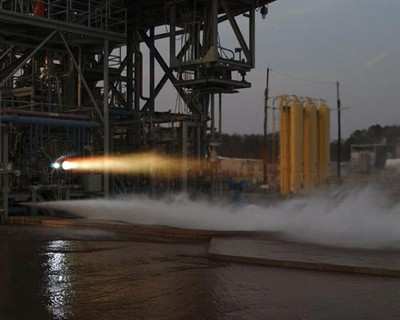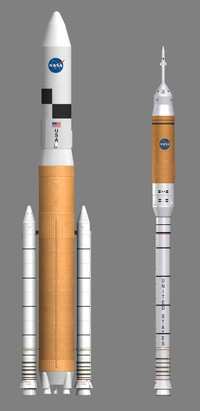Will Build New Test Stand At Stennis For J-2X Evaluation
NASA engineers have successfully completed testing of subscale
main injector hardware, an early step in development of the RS-68
engine that will power the core stage of NASA's upcoming Ares V --
the cargo launch vehicle that will deliver large-scale hardware and
systems to space for exploration missions to the moon.

Engineers at NASA's Marshall Space Flight Center in Huntsville,
AL recently conducted multiple hot-fire tests on the injector
hardware. The injector is a major component of the engine that
injects and mixes liquid hydrogen and liquid oxygen propellants in
the combustion chamber, where they are ignited and burned to
produce thrust.
The tests support the design and development of Ares V under the
Constellation Program, which is responsible for overall development
of the spacecraft and launch vehicles systems for NASA's
exploration initiative to return to the moon and travel to Mars and
destinations throughout our solar system.
The tests, begun in February, were part of a series
investigating different injector element designs for propellant
flow. During testing, engineers fired the injectors for durations
of 10 to 20 seconds.
 The hot-fire tests of the hardware
and number of injector elements are part of efforts to investigate
design options and maximize performance of the RS-68 engine. A
cluster of five RS-68 engines will power the core stage of the Ares
V. The engine will be an upgraded version of those now used in the
Delta IV, the largest of the Delta rocket family developed in the
1990s by the US Air Force for its Evolved Expendable Launch Vehicle
Program.
The hot-fire tests of the hardware
and number of injector elements are part of efforts to investigate
design options and maximize performance of the RS-68 engine. A
cluster of five RS-68 engines will power the core stage of the Ares
V. The engine will be an upgraded version of those now used in the
Delta IV, the largest of the Delta rocket family developed in the
1990s by the US Air Force for its Evolved Expendable Launch Vehicle
Program.
Data from the tests also will be used to develop the J-2X engine
systems for the upper stages of Ares V and for Ares I, the crew
launch vehicle that will carry the Orion spacecraft and its crew of
astronauts to Earth orbit.
The injector hardware for the RS-68 and J-2X engines share
design features similar to the subscale hardware, such as the type
of elements and density patterns. This hardware commonality makes
operations more cost effective for both the crew and cargo
vehicles.
And speaking of the J-2X, NASA also announced this week the
space agency will erect a new engine test stand at the Stennis
Space Center in Mississippi, to conduct tests on the test the
revamped engine.
Stennis already is home to Apollo-era test stands that have
served the nation's space program through the shuttle era. The
newly proposed structure will be the first large test stand built
at the center since the 1960s, near the site where the original
Apollo-era J-2 rocket engines that first carried astronauts to the
moon were tested.
Unlike the older structures, the new 300-foot-tall, open-frame
design will allow engineers to simulate conditions at different
altitudes.
NASA engineers need to simulate various altitudes to test the
J-2X's ability to function as a second stage engine for the Ares I
crew launch vehicle and the Earth Departure Stage engine for the
Ares V cargo launch vehicle. To do that, the test stand will
generate approximately 4,620 pounds per second of steam and use it
to reduce the engine test cell pressure.
NASA aims complete the new stand in time to support the first
J-2X engine test in December 2010. An existing test stand at
Stennis also is being modified to test the J-2X engine at sea level
conditions.
"This new test stand will enable the critical testing needed to
verify the Ares I upper stage engine performance at altitude
conditions," said Stennis Center Director Rick Gilbrech. "The
Apollo-era test stands have served us well over the last forty
years, and I'm excited that NASA will have a new stand to help us
accomplish these new goals."
The test stand, along with its control center, propellant barge
docks and access roadways, will be built in Stennis A Complex.
 ANN's Daily Aero-Linx (05.06.25)
ANN's Daily Aero-Linx (05.06.25) ANN's Daily Aero-Term (05.06.25): Ultrahigh Frequency (UHF)
ANN's Daily Aero-Term (05.06.25): Ultrahigh Frequency (UHF) ANN FAQ: Q&A 101
ANN FAQ: Q&A 101 Classic Aero-TV: Virtual Reality Painting--PPG Leverages Technology for Training
Classic Aero-TV: Virtual Reality Painting--PPG Leverages Technology for Training Airborne 05.02.25: Joby Crewed Milestone, Diamond Club, Canadian Pilot Insurance
Airborne 05.02.25: Joby Crewed Milestone, Diamond Club, Canadian Pilot Insurance




